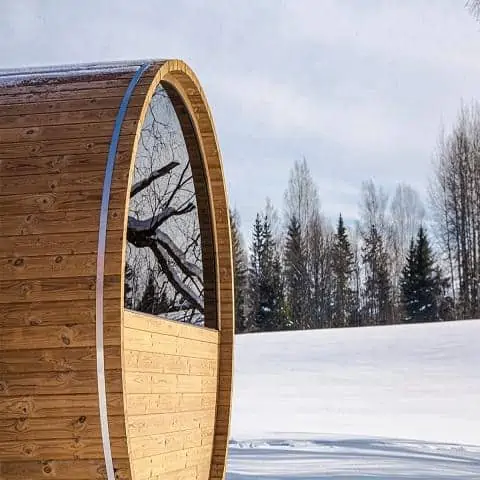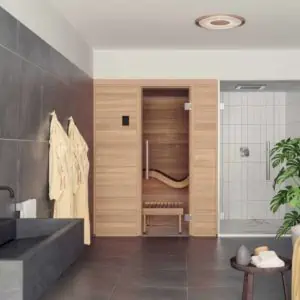Home saunas are an amazing addition to any home, but what does one cost? Learn…

How Much Does a Sauna Cost to Run?
Having a Sauna is an incredible addition to any home, but how much does it cost to run? Let’s find out.
The health advantages of saunas, which have been known for millennia, range from stress relief to increased blood flow. Though enjoying a sauna in the privacy of your own home or garden seems like a treat, you may be wondering how much it costs to maintain. In this post, we’ll take a look at how much it typically costs to maintain a sauna, both steam and infrared varieties, and provide some suggestions for cutting down on that expense.
Breaking Down the Cost of Running a Sauna
Depending on the size of the sauna and how powerful the sauna heater is, the annual cost of maintaining a home sauna may range widely. Here’s how to calculate the cost of running a sauna:
Cost = (Wattage of sauna heater * Hours of use per day * Days per year) / 1000 * Cost of electricity per kilowatt-hour
Where:
- Wattage of sauna heater is the power consumption of the sauna heater in Watts.
- Hours of use per day is the average number of hours the sauna is used each day.
- Days per year is the number of days the sauna is used in a year.
- Cost of electricity per kilowatt-hour is the cost of electricity per unit of energy consumed, typically measured in cents or dollars per kilowatt-hour (kWh).
Example: Wattage of sauna heater = 6000W. 1 hour of use per day. Every day for 1 year. Cost of electricity = $0.12 per kilowatt hour.
Cost = (6000 * 1 * 365) / 1000 * 0.12 = $261.20 per year.
How Much Does a Sauna Cost to Run?
Wondering how much does a sauna cost to run? The answer depends on factors like sauna type, size, usage frequency, and your local electricity rates. Whether you’re considering an outdoor sauna, an in-home sauna, or a 2-person sauna, understanding the cost to run a sauna is key to budgeting for this wellness investment. Let’s break it down.
For an electric sauna, costs typically range from $14.40 to $27 per month based on daily 30-minute use at an average U.S. electricity rate of $0.12 per kWh. Infrared saunas, known for energy efficiency, might cost as little as 15 cents to $1 per hour, while traditional steam saunas can hit $0.72 per hour for a 6 kW model. Outdoor saunas like barrel saunas or wood-burning units add variables like firewood costs—around $40–$50 monthly for twice-weekly use. Plus, sauna maintenance costs add $150–$200 annually for upkeep like cleaning and repairs.
The sauna cost per hour varies by type: infrared models are often the cheapest, while wood-burning saunas may have higher operational costs due to fuel. Understanding how much do saunas cost to run helps you plan for both initial investment and ongoing expenses.
| Sauna Type | Monthly Electricity/Firewood Cost | Annual Maintenance Cost | Total Monthly Cost (w/ Maintenance) |
|---|---|---|---|
| Infrared (6 kW, 40 min/day) | $14.40 | $150 | $26.90 |
| Traditional Electric (6 kW, 75 min/day) | $27.00 | $150 | $39.50 |
| Wood-Burning (2x/week) | $40–$50 | $200 | $56.67–$66.67 |
Factors Affecting Sauna Operating Costs
Several variables influence how much it costs to run a home sauna. Beyond sauna type and electricity rates, factors like insulation quality, frequency of use, and session duration play significant roles. For instance, a well-insulated sauna retains heat better, reducing energy consumption. Frequent use increases the cost to run sauna, but shorter sessions can keep expenses low. Additionally, the sauna maliyeti (cost) can vary depending on whether you opt for a compact 2-person sauna or a larger outdoor model. Understanding these factors helps you estimate how much electricity does a sauna use and plan your budget effectively.
| Sauna Size | Typical Wattage | Hourly Cost ($0.12/kWh) | Monthly Cost (30 min/day) |
|---|---|---|---|
| 1-2 Person | 1.6–3 kW | $0.19–$0.36 | $5.70–$10.80 |
| 3-4 Person | 4–6 kW | $0.48–$0.72 | $14.40–$21.60 |
| 5+ Person | 6–9 kW | $0.72–$1.08 | $21.60–$32.40 |
How Much Does It Cost to Run an Electric Sauna?
The cost to run an electric sauna hinges on its wattage and your local rates. A 6 kW electric sauna used for 1 hour daily costs about $0.72 per session at $0.12/kWh, totaling $21.60 monthly. For a 2-person sauna, costs might range from $25–$50 monthly, depending on size and power. Curious about how much electricity does a sauna use? A typical session consumes 3–6 kWh, making electric saunas a predictable expense.
How Much Does It Cost to Run an Infrared Sauna?
How much does it cost to run an infrared sauna? These units are often cheaper, with a 6 kW model costing $14.40 monthly for 40 minutes daily at $0.12/kWh. Infrared saunas use less power—sometimes under 1.6 kW for smaller units—making them a budget-friendly option for in-home saunas. Their sauna electricity cost can be as low as 15 cents per hour, ideal for cost-conscious users.

How Much Does It Cost to Run an Outdoor Sauna?
For an outdoor sauna, costs vary by type. An electric outdoor sauna for sale might mirror indoor electric costs ($25–$50 monthly), while a wood-burning model depends on firewood—$5–$7.50 per session, or $40–$50 monthly for twice-weekly use. Outdoor saunas from retailers like Costco may offer deals, but factor in weatherproofing and maintenance for accurate sauna running costs.
Are Saunas Expensive to Run?
Are saunas expensive to run? Not necessarily. Home saunas can be affordable, with sauna operating costs ranging from $14 to $67 monthly, depending on type and usage. Compared to other home luxuries, saunas are reasonably priced to operate, especially with energy-saving tips.
Comparing Sauna Costs by Region
The cost of running a sauna varies significantly by region due to differences in electricity rates. For example, operating a 6 kW electric sauna in Idaho (9 cents/kWh) costs about $16.20 monthly for 30-minute daily use, while in Hawaii (34 cents/kWh), the same sauna could cost $61.20 monthly. In the UK, outdoor sauna costs may also differ based on local energy prices, which average around £0.15/kWh. When budgeting for how much it costs to run a home sauna, check your local utility rates to get a precise estimate of your sauna electricity cost.
| Region | Average Electricity Rate | Monthly Cost (6 kW, 30 min/day) |
|---|---|---|
| Idaho, USA | $0.09/kWh | $16.20 |
| Hawaii, USA | $0.34/kWh | $61.20 |
| UK | £0.15/kWh | £27.00 |
How to Save Money Running a Home Sauna
The monthly operating cost of a home sauna may be reduced in a number of ways. The temperature should be lowered, the door should be kept closed, the sauna heater should be cleaned periodically, the usage of sauna accessories should be minimized, and the sauna should be turned off immediately after use.
To cut sauna running costs, opt for an energy-efficient model like an infrared sauna, use it during off-peak electricity hours, and insulate outdoor saunas to retain heat. These steps can make how much it costs to run a home sauna more affordable.
What Other Costs Does a Traditional Home Sauna Include?
The expense of maintaining a classic at-home sauna extends much beyond that of the electricity bill. Maintenance expenses, accessory fees, and cleaning fees are need to be included in. Also, if the sauna has any breakdowns or malfunctions, you will likely be responsible for the associated repair charges.
Maintenance Costs of a Traditional Home Sauna
The cost to maintain a home sauna varies with the number of times used and the specific needs of the unit. A sauna should be cleaned and serviced at least once a year, and its heater and other components may need attention at regular intervals.
How much does it cost to maintain a sauna? Expect $150–$200 yearly for basic upkeep, with sauna repair costs varying based on issues like heater replacement.
Cleaning Fees of a Traditional Home Sauna
A sauna’s upkeep costs are proportional to the frequency with which it is used and cleaned. There may be a higher cleaning cost if you use your sauna more than a few times each week.
Accessory Costs of a Traditional Home Sauna
Prices for sauna extras like stones, lighting, and sound systems may really add up. Incorporating some of these extras into your sauna setup might provide for a more pleasurable and relaxing experience.
Repair Costs
A home sauna’s repair bill might fluctuate widely depending on the condition of the unit and the cost of the necessary replacement components. When a heater stops working properly, the two most expensive parts to replace are the heater itself and any damaged electrical connections.
What is a Sauna?
A sauna is a small room heated to between 80 and 100 degrees Celsius, usually using an electric sauna heater. Saunas are a popular way to unwind and cleanse the body, with most users sitting or lying down to make the most of the sauna’s heat and humidity. Sauna use is often combined with other methods of improving health and well-being.
What Types of Saunas Are There?
There are many saunas available for use, and the one you choose should be based on your preferences.
- Wood-burning sauna heaters provide the power for traditional Finnish saunas, which primarily employ dry heat and heat rocks to create heat.
- It is also possible to use a dry sauna, which does not add any humidity to the air but still provides a relaxing experience.
- Infrared home saunas come in a range of forms and sizes, including prebuilt saunas, precut sauna kits and bespoke saunas. Infrared heating components are used in these saunas to provide a gentler, gentler heat.

Can You Install a Sauna in Your Home?
A sauna may be built inside your house, the answer is yes. Your investment will depend on the required square footage, heat source type, and output. Materials, installation, permissions, and alterations may all need to be included in at extra expense.
Looking for an indoor sauna or outdoor sauna? Both are viable options with Epic Hot Tubs. Home saunas in the UK or U.S. can be customized, with costs varying by size—like a two-person sauna—and installation complexity.
How Does A Home Sauna Work?
The purpose of a private sauna is comparable to that of a public sauna. In a sauna, infrared waves or electric heaters are used to produce heat, which is then distributed uniformly throughout the space. Traditional steam saunas, which are used in certain home settings, call for hot rocks and heated towels to create and sustain the steam.
How much power does a sauna use? It depends on the heater—electric models range from 1.6 kW for infrared to 6 kW for traditional units. Do saunas use a lot of electricity? Not excessively; a typical session uses 3–6 kWh, manageable for most households.
Infrared Sauna vs Traditional Steam Saunas
It’s possible to choose between infrared and conventional steam saunas as a home sauna option. In order to produce steam and a hot, humid atmosphere, traditional steam saunas require dry heat, usually from wood-burning sauna heaters. On the other side, infrared saunas use infrared heated materials to provide a milder, cooler sauna experience.
Infrared or Traditional Steam Sauna?
The benefits of infrared saunas vs ordinary steam saunas depend on the individual’s desire and health. As opposed to traditional saunas, infrared saunas use infrared radiation to produce heat and provide a comfortable, relaxing atmosphere. If you suffer from rheumatism or just want to boost your circulation, a visit to a traditional steam sauna is for you.
From a cost perspective, infrared saunas often have lower sauna operating costs due to their efficiency, while traditional steam saunas might appeal to those seeking a classic experience despite higher electric sauna costs.
Most Frequently Asked Questions
Are Saunas Expensive to Run?
Costs associated with maintaining a sauna range from zero to several hundred dollars a year, depending on factors such as the sauna’s size, power rating, the cost of energy, and any special features you choose. Costs associated with maintaining a sauna are usually manageable, but they may build up over time.
How Much Does a 2 Person Sauna Cost to Run?
How much it costs to operate a 2-person sauna is contingent on factors such as the heater’s size and wattage, as well as the local cost of power. Costs to operate a 2-person sauna typically range from $25 to $50 per month.
How Much Does It Cost to Run an Outdoor Sauna?
Costs associated with maintaining an outdoor sauna vary widely, depending on factors such as sauna style, sauna size, heat source, and local energy rates. The cost to operate a sauna increases in direct proportion to its size and power output, thus a bigger, higher-wattage sauna will cost more to maintain over time.
How Much Does It Cost to Run a Barrel Sauna?
The cost of operating a barrel sauna varies on the kind of sauna, wattage, and the cost of power in the region. In general, the bigger and more powerful the sauna, the more power it will use and the greater the monthly cost of its operation.
How Much Does an Infrared Sauna Cost to Run?
Depending on factors like the infrared sauna’s size and power rating and the local cost of energy, its operating expenses might range widely. A typical infrared sauna might cost anything from 15 cents to over a dollar per hour to use.
How Expensive is a Sauna to Run?
Multiple variables affect how much it will cost to purchase and operate a sauna, including the square footage, power consumption, and degree of personalization you’d want. Though the expenses associated with maintaining a sauna may pile up over time, they are usually manageable for the average household budget.
Conclusion
For ages, people have turned to saunas for stress relief and detoxification, among other physical and mental health benefits. The convenience of having a sauna in your own home or garden is undeniable, but it’s crucial to factor in the ongoing expenses involved. Power consumption varies widely depending on sauna model and wattage, so it’s important to do your homework and weigh all the variables relevant to your circumstance before settling on a sauna. Get in touch with us at Epic Hot Tubs by filling our the form or calling us at 888-884-3742 for specifics on sauna installation and pricing.

We ship saunas throughout the United States and offer assembly throughout NC.
Give us a call at 888-884-3742 or fill out the form to learn more.
Richard Horvath
Richard has been in the hot tub & spa industry for years. As a long hot tub & swim spa owner himself, Richard has a passion for helping homeowners create their dream backyard.



